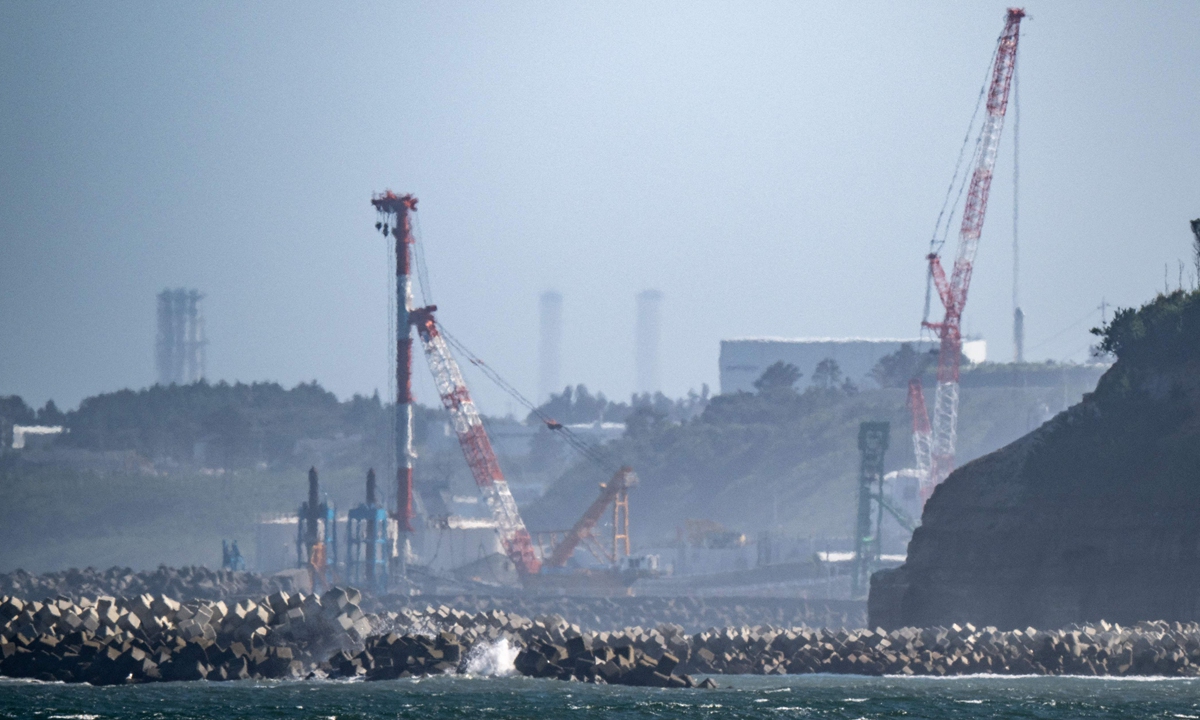
A view shows the facilities of the Tokyo Electric Power Company's crippled Fukushima Daiichi Nuclear Power Plant, as seen from Ukedo fishing port in Namie, Fukushima prefecture on August 24, 2023. Photo: VCG
Editor's Note: Despite worldwide oppositions and criticism, the Japanese government went ahead with its nuclear-contaminated wastewater dumping plan on August 24, opening a Pandora's Box of unfathomable consequences. Rather than responding to global concerns, the Japanese government attempts to obfuscate public spotlight by transforming itself into a victim.
Japan had reportedly dumped more than 4,000 tons of nuclear-contaminated wastewater as of Tuesday. It detected radioactive tritium in seawater off the Fukushima Daiichi nuclear power plant for the first time on August 31, the plant operator Tokyo Electric Power Company (TEPCO) said the following day.
The Japanese government's reckless wastewater dumping, which may last as long as 30 years, is likely to bring far-reaching consequences to the global marine ecosystem and cause unpredictable damage. Worse still, in order to whitewash its evil deeds, the Kishida administration and TEPCO have resorted to deception and smear campaigns to mislead the public.
Why is the nuclear-contaminated wastewater being dumped by Japan actually not in accordance with discharge standards as the country claims? What tricks have been used by the country to attempt to cover up the truth and gain the international community's support? The Global Times recently talked to some experts in marine ecology and nuclear radiation and insiders who are familiar with Japan's dumping plan, so as to expose the lies of the Japanese government and the reason why Japan is so keen to act as a "victim."
Nuclear wastewater VS radioactive wastewater One of TEPCO and the Japanese government's main efforts to whitewash its nuclear-contaminated wastewater dumping plan is to confuse the concept with normal nuclear wastewater by insisting that the water are and plan to continue dumping into the ocean has been treated.
But the two concepts are entirely different.
Nuclear wastewater is generated during the normal operation of nuclear reactors and the application of radioisotopes in nuclear power plants, such as reactor coolants. Such wastewater does not directly come in contact with nuclear fuel and reactants, and is released safely.
However, radioactive wastewater or nuclear-contaminated wastewater is generated after coolant directly comes in contact with radioactive materials when released after a nuclear reactor shield is broken accidentally. Such wastewater is highly radioactive and contains dozens of radioactive materials that are seriously harmful to human being and the environment. Some radioactive materials in this water have very long half-lives. Iodine-129, for instance, has a half-life of 15.7 million years and Carbon-14's half-life is 5,730 years.
Moreover, at a normal power plant, nuclear materials are enclosed within the reactor. But when the reactor is destroyed, the nuclear materials might continue to leak out and dissolve in the water, making the water contaminated and leading to long-term damage.
Taking these facts into account, the wastewater dumped from the Fukushima nuclear power plant is typical nuclear-contaminated wastewater. Confusing such water with normal nuclear wastewater reflects a guilty conscience and the knowledge that dumping the water into the ocean is wrong, experts pointed out.
They asked that if Japan equates the nuclear wastewater produced by a normal reactor to nuclear-contaminated wastewater, and really believes that the water it is dumping is clean and safe, why doesn't the country reuse it as industrial water?
Meet discharge standards?Japan reportedly uses a very simple and self-deceptive way to make the wastewater it plans to continue dumping superficially "safe": It diluted the nuclear-contaminated wastewater at a ratio of 1:100 with seawater before release.
That doesn't change the total amount of the nuclear-contaminated wastewater Japan plans to dump, nor does it reduce any possible damage to the marine environment. The trick, as the Associated Press reported on August 22, does bring the current released water below international safety limits, "but its radioactivity won't be zero."
Through the years, Japan has babbled on and on about its self-made nuclear-contaminated wastewater treating system, bragging that its facilities are able to meet release standard compliance. The Advanced Liquid Processing System (ALPS), one of the key facilities TEPCO designed to deal with the wastewater to be discharged, started trial operations as early as March 2013.
Since then, Japan began to refer to the nuclear-contaminated wastewater treated at the ALPS as "treated water," to create an illusion that the water to be dumped is safe after "treatment."
This deceptive term doesn't change the fact that the ALPS-treated water is far from meeting international release standards, as data provided by TEPCO showed that as of September 30, 2021, some 70 percent of the then 1.243 million cubic meters of ALPS-treated nuclear-contaminated wastewater still failed to meet the criteria, 18 percent of which even exceeded the standard 10 to 20,000 times over.
Additionally, the ALPS facility has experienced frequent malfunctions. In August 2021, for instance, TEPCO found that there were at least 10 breakages on the filters used to absorb nuclides. A month later, TEPCO announced that five more filters in the ALPS were found to have been damaged, and radioactive contamination had been detected near some of the filters.
The lack of supervision in Japan's water treatment has also causes widespread concern. During a recent foreign media tour to the discharge site, when a French journalist suggested that a third party such as an environmental group or expert should participate in the measurement or monitoring of radiation in order to increase credibility, TEPCO's Kenichi Takahara, who was responsible for the on-site coverage, "immediately reacted negatively," Yonhap News Agency reported on September 3.
TEPCO and the Japanese government should guarantee comprehensive, timely, and complete publishing of data regarding the process of the dumping and accept supervision by the international community, Ma Jun, director of the Beijing-based Institute of Public and Environmental Affairs, told the Global Times at the weekend.
IAEA, authoritatively backed?Japan claims the water release has been backed by the IAEA and authoritative scientists. To get IAEA to endorse its dumping plan, the Japanese government provided the IAEA with at least 1 million euros as a sort of political donation, two South Korean media sources said in June.
The Japanese Foreign Ministry later issued a denial. Nonetheless, in an article published on July 8, Japanese newspaper Tokyo Shimbun quoted "a ministry official" as saying that the whole Japanese government "invested a lot of money in the IAEA and sent a lot of personnel there, to ensure its (Japan's) presence" in the IAEA's decision making.
It's worth noting that, no matter how much money Japan has offered to the IAEA, the latter has never openly vouched for Japan's wastewater discharge plan as being rational or reliable.
Although a recent assessment report presented by the IAEA Director General Rafael Grossi to the Japanese government concluded that the discharge plan "is in conformity with the agreed international standards," it stressed at the beginning that it does not necessarily reflect the views of IAEA member states and is not a recommendation or an endorsement of Japan's ocean dumping plan.
Liu Senlin, an expert with the China Institute of Atomic Energy, who participated in the IAEA's technical working group for the assessment, told the Global Times previously that the report was released hastily and lacked sufficient consultation with experts. China's permanent representative to the IAEA, Li Song, also pointed out that the conclusions of the agency's report were one-sided and lacked credibility.
Globally, organizations such as Greenpeace and the US National Association of Marine Laboratories have openly opposed Japan's wastewater dumping plan. "[The discharge] ignores human rights and international maritime law," Greenpeace criticized in a press release on August 22.
Huge 'PR budget' works?
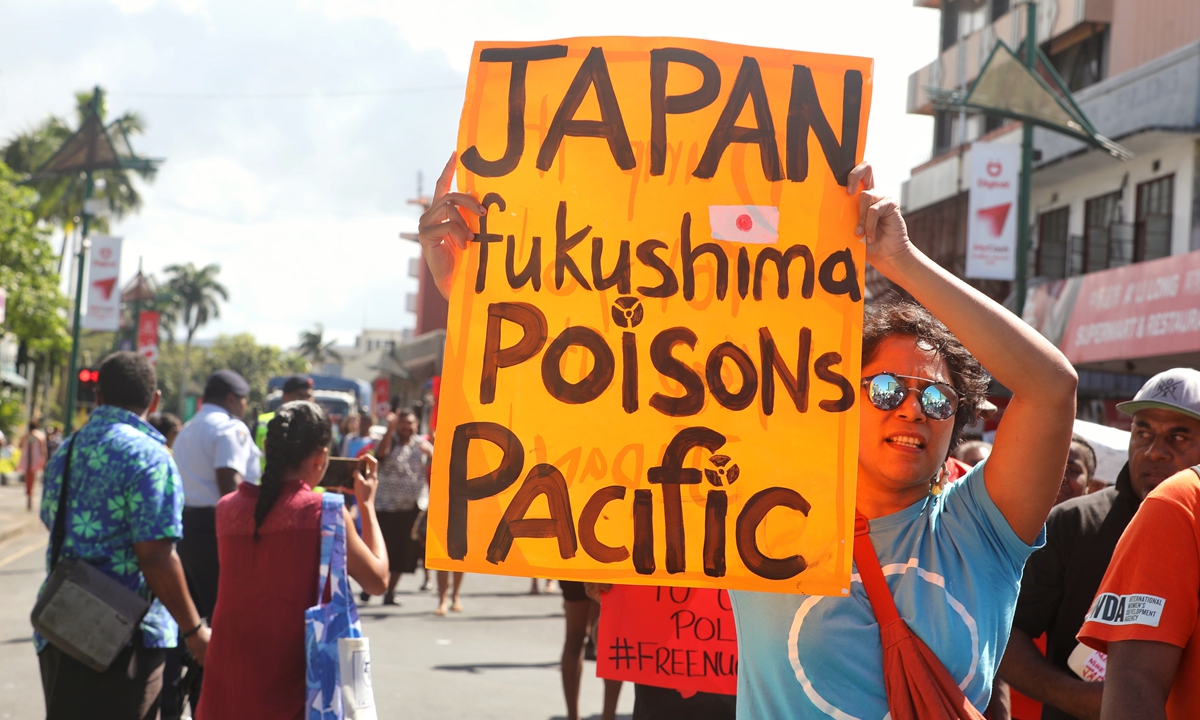
Protesters in Suva, the capital of Fiji, march against the release of nuclear-contaminated wastewater from Japan, on August 25, 2023. Photo: Xinhua
The Japanese Foreign Ministry had increased its 2024 budget specially designed to respond to "disinformation" about the nuclear-contaminated wastewater dumping plan to approximated 70 billion yen ($478 million), the NHK reported on August 24, when Japan started the release process.
The 70-billion-yen "PR budget" is allegedly almost 20 times the budget for the nuclear-contaminated water dumping, and twice the budge for an alternative steam discharge. "It can be seen that the Japanese government is more inclined to spend money on public relations in dealing with the issue of Fukushima nuclear sewage than to adopt a safer treatment plan," said Min News on Monday.
Compared with putting forward a safer plan, Japan seems to have spent much more money and energy in justifying its unscrupulous wastewater dumping plan, hiring professional PR companies to confuse the public by frequently spreading false information including "effects of the Fukushima accident have been eliminated" and "the water to be discharged is safe," observers found.
Some of its PR methods have been laughably ridiculous. In 2021, the Japanese government contracted advertising giant Dentsu to come up with a promotional campaign for the dumping plan. Ironically, what Dentsu did to whitewash the dumping plan, was to invent a cute cartoon character for the radioactive particle tritium.
The campaign unsurprisingly backfired, and the tritium "mascot" was scrubbed from the internet after just two days, Kyodo News reported in April 2021.
Japan's various whitewash campaigns and playacting can't change the fact that the Fukushima nuclear-contaminated wastewater and fish therein are likely to be harmful. Many people around the globe are well aware of that, as the Fukushima seafood was declined by many countries' athletes during the Tokyo Olympics in 2021. The South Korea team openly said it brought in own food instead to avoid possibly contaminated Fukushima ingredients.
Japan is a victim? In addition to ridiculous PR stunts, the Japanese government has also been actively conducting high-level communications to attract more supporters while setting China as a common target to shift focus.
Despite the US President Joe Biden's claim that the US-Japan-South Korea summit at the US presidential retreat Camp David held on August 18 "is not about China," afterward the leaders of the three countries explicitly picked on China under the pretext of "joint efforts to maintain peace and stability" in the Taiwan Straits and the South China Sea, which once again laid bare rife anti-China hypocrisy, Chinese observers criticized.
After the meeting between South Korean President Yoon Suk-yeol and Japanese Foreign Minister Fumio Kishida in May, the South Korean government's position has undergone an obvious shift.
After Japan's Minister for Foreign Affairs Yoshimasa Hayashi's visits to several Pacific island countries in March such as Tuvalu and Sao Tome and Principe, these countries' positions also became ambiguous. The main economic drivers of Pacific island countries are tourism and the fisheries. As Japan is a leader in global fisheries technology, experts deemed that Japan may have made some commitments to support the development of fisheries in these island countries in exchange for the latter's silence on the dumping plan.
The Japanese government is also concocting false propaganda to divert attention. Recently, the Japanese Embassy in China held a briefing for foreign media in Beijing, but did not invite Chinese media outlets, aiming to provide targeted publicity for foreign media and indirectly influence public opinion in China.
Chinese observers pointed out that what the Japanese government's expectation is, as long as the Geiger counter doesn't explode within seconds after contact with the wastewater, or a Godzilla monster-like would not suddenly emerge from the sea, the dumping can be acceptable. As for questions like whether there will be man-tall crabs or Cthulhu-esque octopuses in 30 to 40 years is not part of its consideration. Moreover, the potential problems that may occur 30 years later will no longer be the current government's concern. This is the Japanese government's logic.
China, by contrast, is motivated by providing an effective public good by taking a stand against Japan's wastewater dumping. If China, through its own efforts, makes Japan change its decision, or deal with the wastewater in a safer way, that will ultimately benefit the entire Pacific Ocean and all the people involved, and that is a real public good, an expert familiar with Japan's dumping plan said.
Sadly, when China stands up such a foolhardy plan, certain countries resort to using environmental protection as a business and slogan, or a label to seek personal political influence.
A public good can only be provided by responsible powers. Since Japan commenced dumping nuclear-contaminated wastewater into the sea, the Chinese government has not hesitated to shoulder its responsibility and clearly point out that the dumping will harm the entire ocean.
"Some US media outlets even claimed that China would be the last to be affected from the perspective of ocean circulation. So why is China stepping up?" an anonymous expert told the Global Times. "Because what China has been doing is for the sake of being responsible to humanity and the country really cares about environmental protection."
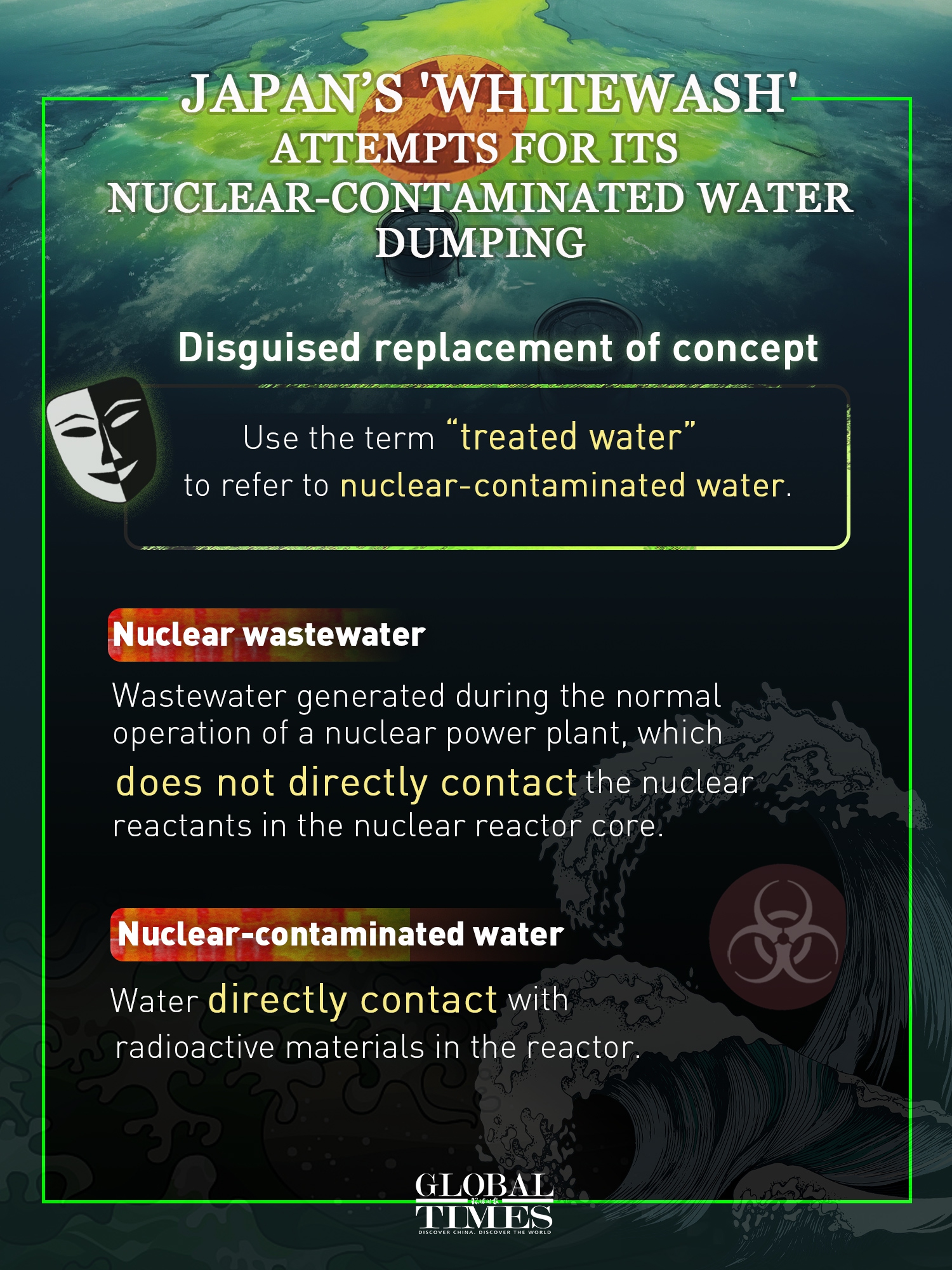
Sources: Guangming Net, CCTV News, NHK News, Embassy of Japan in China, the Japan Times, Reuters Graphic: Yu Tianjiao/GT
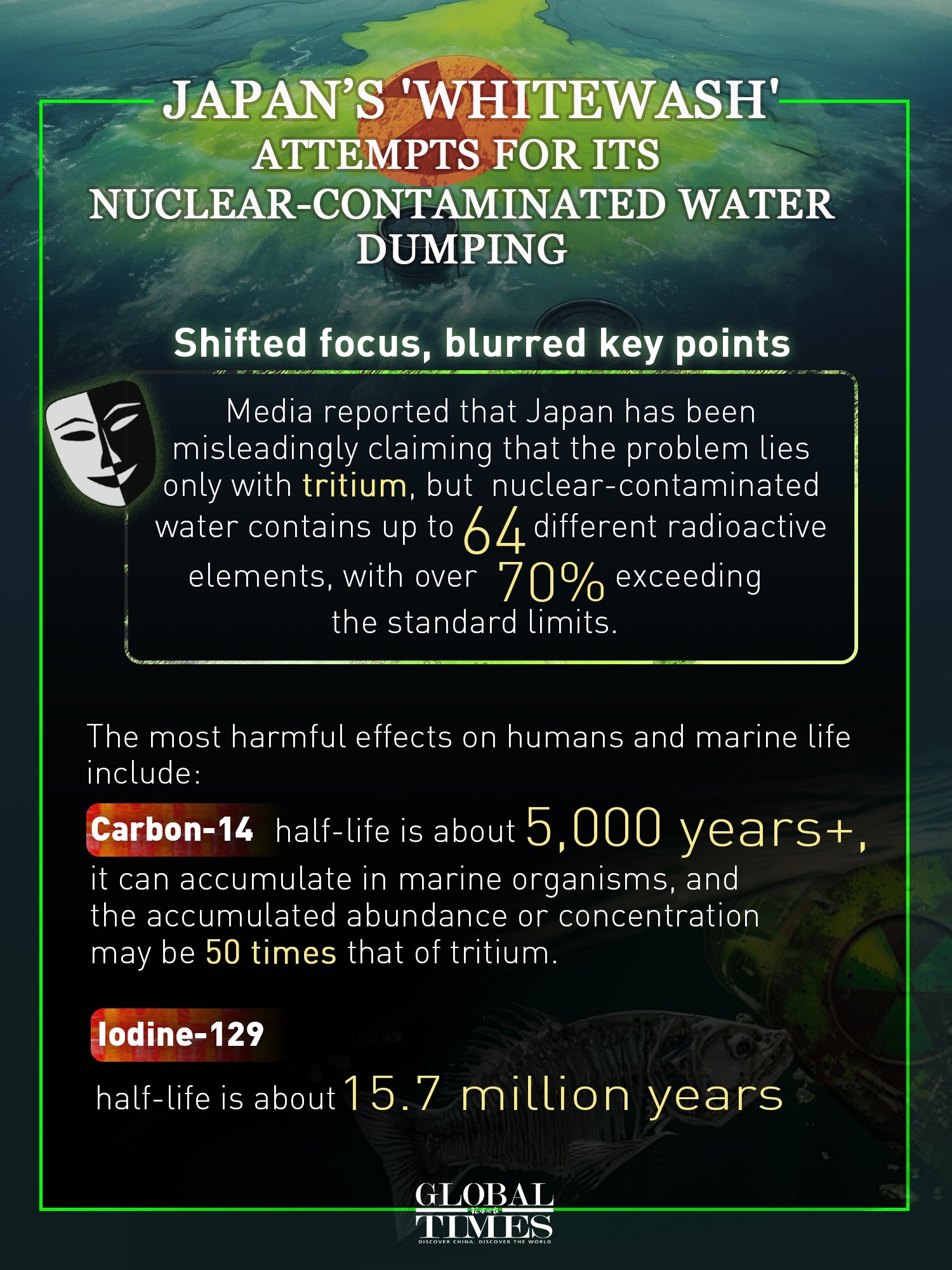
Sources: Guangming Net, CCTV News, NHK News, Embassy of Japan in China, the Japan Times, Reuters Graphic: Yu Tianjiao/GT
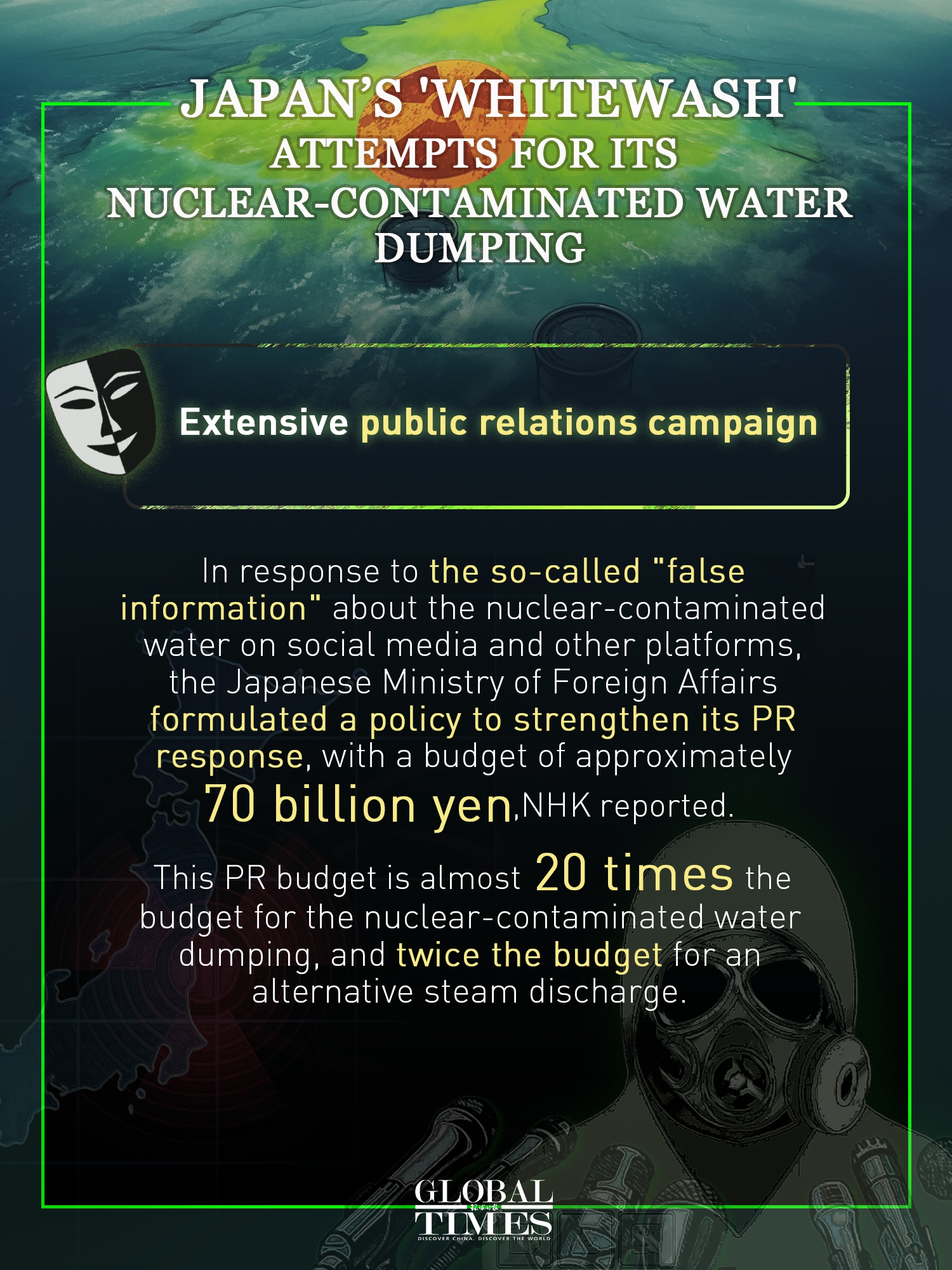
Sources: Guangming Net, CCTV News, NHK News, Embassy of Japan in China, the Japan Times, Reuters Graphic: Yu Tianjiao/GT

Sources: Guangming Net, CCTV News, NHK News, Embassy of Japan in China, the Japan Times, Reuters Graphic: Yu Tianjiao/GT
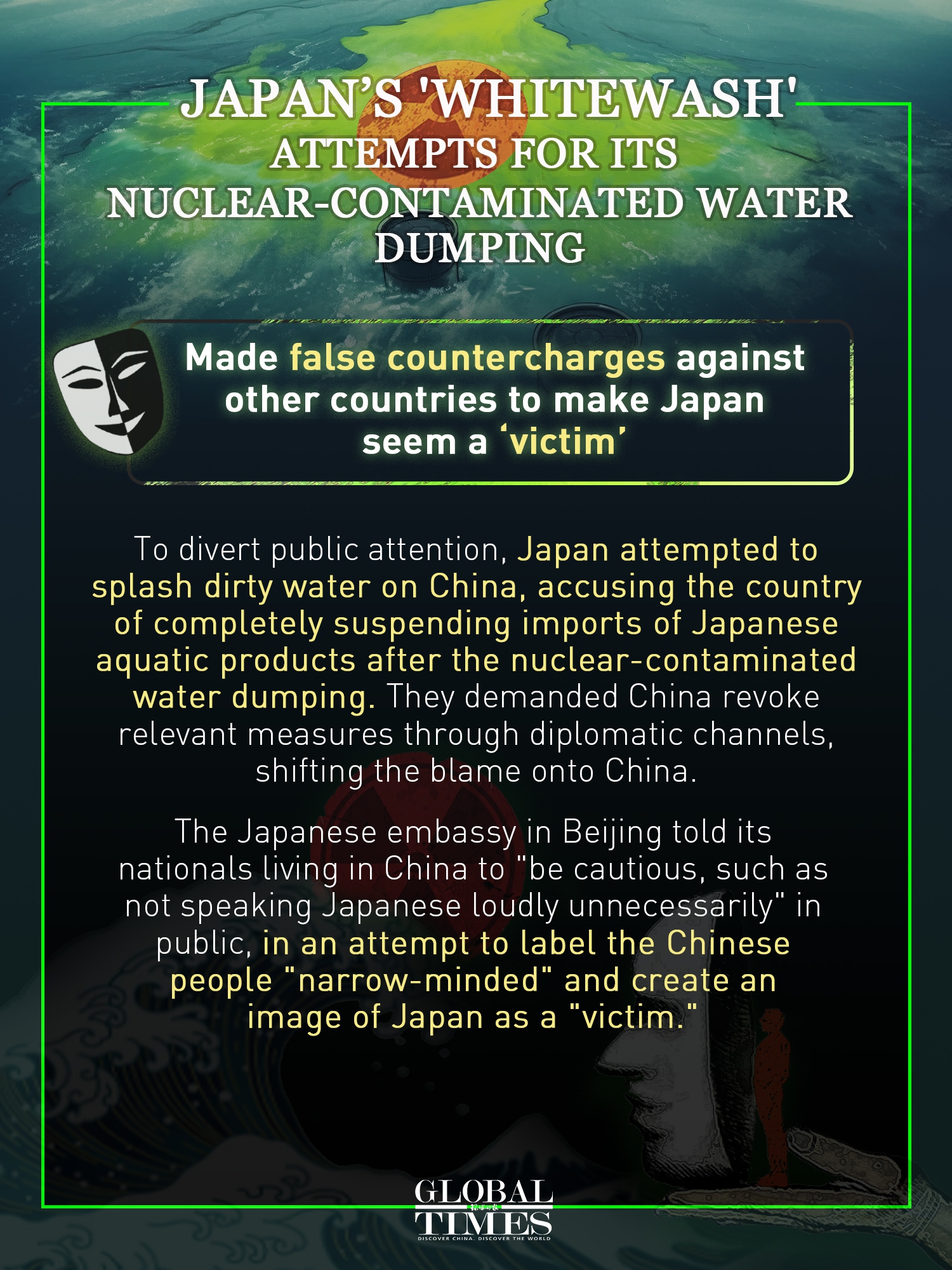
Sources: Guangming Net, CCTV News, NHK News, Embassy of Japan in China, the Japan Times, Reuters Graphic: Yu Tianjiao/GT










